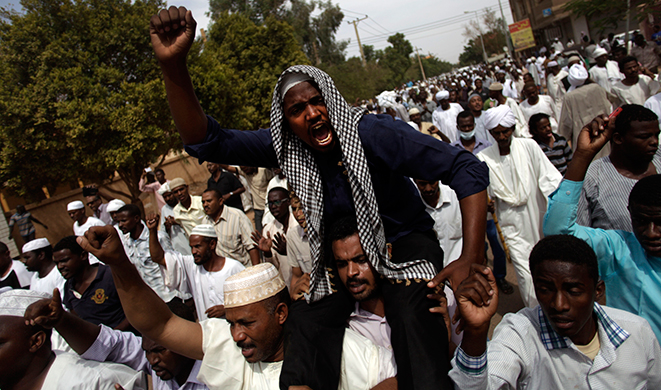
Editor's Note: This op-ed by Enough Project Research Associate Nada ElSayed originally appeared on Sudan Tribune.
It seems as though Sudan’s peaceful protest movement, which took on a more subdued tone after the state security forces’ mass detentions and shoot-to-kill policies, has been lost in translation as well. External analysts seem to be waiting for an Arab Spring that would signal the end of the NCP regime. However, the incipient Sudanese revolution merits analysis on its own terms and is best compared to earlier successful Sudanese revolutions.
History might not repeat itself, but we often hear echoes from the past in current events. The current movement for change in Sudan is reminiscent of earlier revolutions – in 1964 and 1985 – but it is moving to the beat of the new generation that were raised to be fearful the Omar Al-Bashir, National Congress Party-led regime.
Their grandparents protested in 1964, as participants in symposiums as students, as part of the dissenting general public as protesters, as professionals, and as members of the military junta who defected and stood by the people as they revolted against the regime of General Ibrahim Abboud. Thirty-four deaths and 153 injuries later, in a wave of mass protests around the country reached the presidential palace. President Abboud resigned and handed over of power to a transitional body in October of 1964.
Their parents toppled the military regime of President Muhammad Numeiri who came to power in a military coup on May 25, 1969. Although political oppositional parties had tried unsuccessfully to overthrow the regime in 1970 (the Ummah party) and in 1971 (the Sudanese Communist Party), the people did not lose hope. They waited over ten years. Numeiri strengthened the state’s national security prowess by recruiting 45,000 security officers, arming them, giving them their own radio, television and communications network, and training them as spies for the regime. Still, protesters were able to make their voices heard. The 1983 imposition of Islamic Sharia and many other grievances including the nascent civil war in the southern part of the country sparked a new revolution. For two years, Sudanese planned, organized and took the streets in a series of strikes, protests until the regime was toppled. The economic situation had also greatly deteriorated after the implementation of austerity measures recommended by the IMF. Strikes took place over two years in 1984 and 1985 and again brought together trade unions and professionals. In 1985, a massive strike followed by a march where over two million people took the streets, turned the tables. While the president Numeiri was on a visit to the United States he was deposed.
These two homegrown successful revolutions could guide and inspire the youth of Sudan who are on the frontlines of the current uprising. Bashir’s regime has had 24 years to install a strong National Security and Intelligence Services that respond to any form of dissent with a massive use of force. The response to the current protests has resulted in the deaths of 210 protesters and the detention of over 2000 people. Moreover, the regime has infiltrated and weakened trade unions and placed restrictions on civil society making mass support through trade unions impossible. While the majority of the state’s budget has been spent on the military and the wars in Darfur, South Kordofan and until recently, South Sudan, the Sudanese people have been surviving on meager salaries. For years, Sudanese people living under the current government had to decide between taking to the streets and feeding their families. Now, after the latest round of austerity measures, economic conditions have become so dire that most Sudanese cannot even afford basic necessities. That frustration and anger pushed them to the streets in late September.
While this new revolution gains traction and experiments its way to a successful outcome, there are important lessons to be learned from the previous revolutions of Sudan. Times are difficult now with the brutal crackdowns by the police, military and NISS. However, there is hope. It took two years of pressure to overthrow the Numeiri regime. There is a need for more organization, among youth, professionals, political parties and independent political activists inside and outside Khartoum. Protests alone are not enough. A combination of protests, general and political strikes and government boycotts, and a counter-elite leadership, preferably from the military, that is willing to stand by and lead to a safe transition of power, may be necessary as we have learned from previous revolutions in Sudan. Magdi Elgizouli also explains “that the post-colonial political order that allowed relatively smooth transitions of authority in Khartoum has exhausted itself over the years.”
One such link to the past is has recently begun. On the 49th anniversary of the first Sudanese revolution in 1964, a number of Sudanese activists all over the world decided to went on a hunger strike for five days: October 21 until Friday, October 25. Their demands include the release of detainees, bringing those responsible for the killing of protesters to justice, freedom of expression, allowing journalists to resume their role and lifting bans on newspapers. Some of those on strike are families of detainees who are protesting the prolonged extrajudicial detention of their loved ones, others are joining in solidarity. Two Sudanese activists, Haytham and AlShafie, in Washington DC were on a public five day long hunger strike for twelve hours a day until Friday October 25th. They carried out their protest in front of the White House and displayed images of massacred protesters from earlier this month. Many more are fasting and contributing their thoughts on the Strike4Sudan blog. As Sudan’s youth grapple and fine-tune a new revolution using 21st century social media, hope still remains based on the lessons of parents and grandparents.

